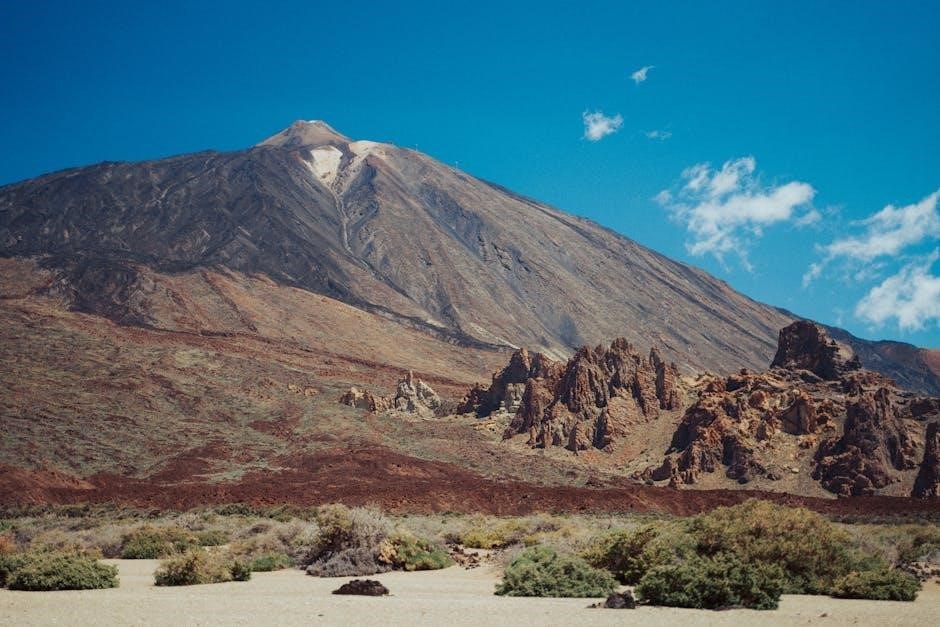The National Geographic Volcano Kit offers an engaging STEM experience, allowing kids aged 8+ to build and erupt their own volcano. With detailed instructions, it combines hands-on learning with geological concepts, making science fun and educational.
Overview of the Kit and Its Purpose
The National Geographic Volcano Kit is an educational STEM tool designed for children aged 8 and above, promoting hands-on learning about geological processes. It includes a volcano mold, eruption powder, plaster, paint, and brushes, along with a detailed instruction manual. The kit’s primary purpose is to enable kids to build and erupt their own volcano, simulating real geological phenomena. By following the instructions, users gain insights into volcanic eruptions, Earth’s structure, and geothermal activities. This interactive kit fosters curiosity, creativity, and STEM skills through a fun and engaging experience.
Importance of Following Instructions
Following the instructions for the National Geographic Volcano Kit is crucial for safety and success. The kit is recommended for children aged 8 and above, with adult supervision required due to the presence of chemicals. Misuse of these materials can pose health risks, highlighting the need to adhere to the provided guidelines. Proper assembly and preparation ensure the volcano’s structure is stable and the eruption works as intended. Ignoring the instructions could lead to failed eruptions or accidents. By carefully following the manual, users can enjoy a safe, educational, and fun hands-on learning experience.
Understanding the Kit Components
The National Geographic Volcano Kit includes a volcano mold, eruption powder, plaster, paint, brushes, and an instruction manual. These components work together to create a functional, customizable volcano model.
Volcano Mold and Structure
The kit includes a durable volcano mold designed to create a realistic volcanic structure. The mold helps shape the volcano’s form, ensuring a stable base for eruptions. The structure’s design mimics natural geological features, enhancing educational value. Detailed instructions guide users through assembling and securing the mold. The volcano’s shape and size are crucial for effective eruptions. Properly following the mold’s assembly ensures a safe and functional model. This component is essential for the kit’s hands-on learning experience, teaching users about volcanic anatomy and eruption dynamics through practical application.
Eruption Powder and Chemicals
The kit includes eruption powder and specific chemicals designed to create a realistic volcanic eruption. These components are safe when used as directed but require careful handling. The eruption powder reacts with vinegar or water to produce carbon dioxide gas, mimicking a natural volcanic eruption. Instructions emphasize proper mixing ratios and safety precautions. Users should wear protective gear and ensure adult supervision when handling these materials. The chemicals are non-toxic but must be used responsibly to avoid accidents. Proper storage and disposal are also highlighted in the guidelines to ensure safety and environmental care.
Plaster or Modeling Compound
The kit includes a plaster or modeling compound essential for shaping the volcano’s structure. Mix the compound with water to achieve the right consistency, then pour it into the mold. Allow it to dry completely, either naturally or by placing it in a low-temperature oven. Proper handling ensures a sturdy, realistic volcano shape. Safety guidelines emphasize avoiding skin contact and working in a well-ventilated area. Once hardened, the plaster forms the foundation for painting and customization, making it a critical step in the kit’s assembly process.
Paint and Brushes for Customization
The kit includes acrylic paints and brushes for personalizing your volcano. Use the provided paints to add realistic features like volcanic rocks, ash, and lava. Apply thin layers, allowing each coat to dry completely before adding more details. Brushes of varying sizes help achieve precise strokes and textures. Follow the manual’s tips for creating lifelike effects. Painting enhances the visual appeal and educational value of the model, making it a fun and creative part of the learning process. Ensure the paint is fully dry before triggering an eruption for optimal results. Safety guidelines recommend using non-toxic paints and working in a well-ventilated area. This step allows users to express their creativity while preparing the volcano for its eruption.
Instruction Manual and Safety Guidelines
The kit includes a detailed instruction manual with step-by-step assembly and eruption guides. It emphasizes safety precautions, such as adult supervision for children under 12 and proper handling of chemicals. The manual outlines warning signs and emergency preparedness, ensuring a safe experience. Troubleshooting tips are also provided to address common issues. Adhering to the guidelines is crucial for a successful and hazard-free eruption. The manual serves as an essential resource for both educational and enjoyable use of the National Geographic Volcano Kit.
Safety Precautions and Warnings
Not suitable for children under 8 years; adult supervision required. Handle chemicals safely to avoid health risks. Follow instructions carefully to prevent accidents and ensure a safe experience.
Age Recommendations and Supervision
The National Geographic Volcano Kit is recommended for children aged 8 and above due to the complexity and potential hazards of the activity. Adult supervision is strongly advised to ensure safety and proper handling of chemicals. Younger children may require additional guidance to avoid accidents. Parents or guardians should review the instructions with their child and assist with critical steps, such as mixing chemicals or handling hot materials. This collaborative approach enhances learning while maintaining a safe environment for exploration and creativity.
Handling Chemicals Safely
Handling chemicals in the National Geographic Volcano Kit requires careful attention to safety guidelines. Always wear gloves and goggles to protect against potential irritation. Ensure the workspace is well-ventilated to avoid inhaling fumes. Keep chemicals out of reach of young children and avoid ingesting any substances. Follow the instructions precisely when mixing the eruption powder and other compounds. Never mix chemicals without adult supervision, especially for younger users. Improper handling can lead to skin irritation or other hazards, so caution is essential for a safe and enjoyable experience.
Preventing Accidents During Assembly
To prevent accidents during assembly, ensure the workspace is clear of clutter and liquids. Use protective gloves and eyewear, especially when handling sharp or chemical components. Follow the instructions step-by-step and avoid rushing the process. Secure the volcano mold tightly before adding plaster to prevent spills. Keep tools and materials out of reach of younger siblings or pets. Supervise children closely, especially when handling sharp edges or mixing chemicals. A clean, organized workspace and adherence to safety guidelines minimize risks, ensuring a smooth and safe assembly process for everyone involved.
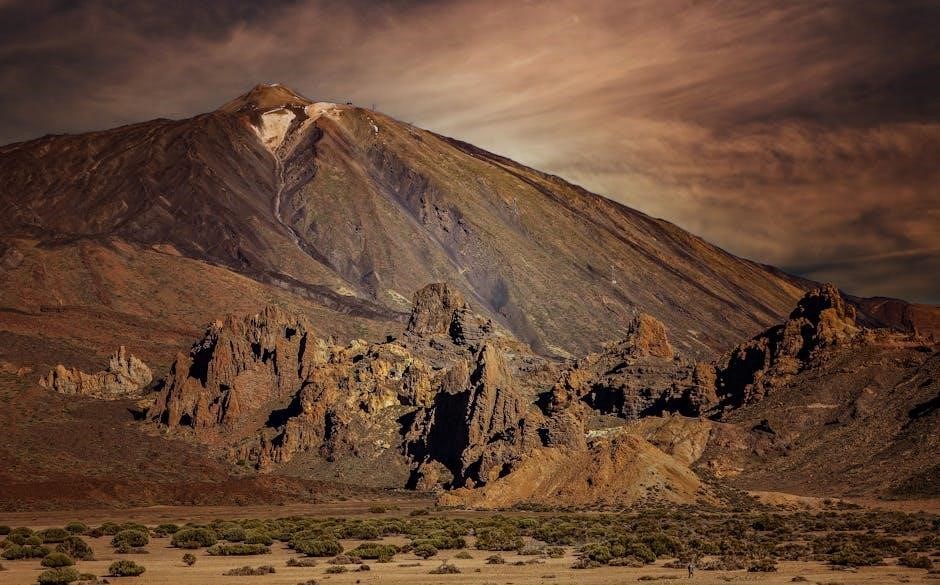
Assembly Instructions
Begin by preparing your workspace and tools. Carefully mold the volcano structure using the provided mold and plaster mixture. Follow the manual for precise assembly steps.
Preparing the Workspace and Tools
Start by clearing a flat, stable workspace and covering it with newspaper or a protective cloth to prevent mess. Gather all tools and materials, including the volcano mold, plaster, measuring cups, and stirrer. Ensure you have the instruction manual readily available for reference. Put on gloves and goggles for safety. Organize the components neatly to avoid confusion. Double-check that all items from the kit are accounted for before proceeding. This preparation ensures a smooth and efficient assembly process for your volcano model.
Molding the Volcano Structure
Begin by preparing the volcano mold according to the kit’s instructions. Mix the plaster or modeling compound with water in a well-ventilated area until it reaches a thick, paste-like consistency. Pour the mixture into the mold, ensuring it fills all areas evenly. Use a spatula or spoon to smooth the surface and remove air bubbles. Avoid overfilling, as this can cause overflow during drying. Let the structure sit undisturbed until it hardens completely, following the recommended drying time. Once set, carefully remove the volcano from the mold, ensuring it retains its shape and stability.
Drying and Hardening the Plaster
After pouring the plaster mixture into the mold, allow it to dry completely. Place the volcano in a warm, dry area for 1-2 days. For faster drying, an adult can put it in a preheated oven at 200°F (93°C) for 1-2 hours. Ensure it cools before handling. A properly dried volcano is essential for a sturdy structure. Letting it dry completely ensures it’s ready for painting and eruption without cracking.

Painting and Customizing the Volcano
Paint the volcano using acrylic or tempera paints, then let it dry completely for a vibrant finish. This step adds a realistic touch, enhancing its appearance for a more authentic look.
Choosing the Right Paint and Brushes
Select high-quality acrylic or tempera paints for vibrant, long-lasting results. Use small, medium, and large brushes for detailed textures and broad strokes. Allow each layer to dry completely before adding additional coats. Opt for earthy tones like brown, gray, and red to mimic real volcanic features. To prevent smudging, work carefully and avoid overloading the brush with paint. For intricate details, fine-tip brushes are ideal. Ensure the paint is fully dry before handling or displaying the volcano to maintain its appearance and durability over time.
Applying Realistic Volcano Features
Enhance your volcano’s realism by adding texture and details. Use a texture paste or modeling compound to create rocky surfaces and ridges. Paint the base with earthy tones like brown and green for a natural landscape. Add layers of gray and black to mimic volcanic rocks; Use a small brush to paint cracks and fissures. Incorporate small rocks or sand for added realism. To create a lava effect, apply red and orange paint around the crater. Follow the kit’s instructions for drying times to ensure a durable finish and a professional-looking volcano model.
Allowing Paint to Dry Completely
Allowing the paint to dry completely is crucial for a durable finish. Place the volcano in a warm, dry area, avoiding humidity. For faster drying, an adult can put it in a low-temperature oven (200°F/93°C) for 1-2 hours. Let it cool before handling. Ensure each coat of paint dries fully before adding additional details. Rushing this step can lead to smudging or peeling. Patience ensures vibrant, long-lasting results. Follow the kit’s guidelines for optimal drying times to achieve a professional-looking volcano model.
The Eruption Process
The eruption process involves mixing the provided chemicals to create a realistic volcanic reaction. Follow the instructions carefully to ensure a safe and impressive eruption experience.
Mixing the Eruption Solution
Mixing the eruption solution is a critical step that requires precision. Start by combining the eruption powder with water in the volcano’s chamber, following the instructions for the correct ratio. Stir the mixture thoroughly until the powder dissolves completely. Allow the solution to sit for a few minutes to ensure all components are well-integrated. Proper mixing ensures a vigorous and realistic eruption. Always handle the chemicals with care and wear protective gloves to avoid any skin irritation. This step sets the stage for a successful and educational eruption experience.
Triggering the Eruption Safely
Triggering the eruption safely is essential for a successful and enjoyable experience. Begin by ensuring the volcano is on a sturdy, heat-resistant surface and clear of flammable materials. Wear protective goggles and gloves to avoid exposure to the chemical reaction. Slowly pour the prepared eruption solution into the volcano’s crater, following the instructions precisely. Stand back immediately after pouring to maintain a safe distance. For multiple eruptions, repeat the process with fresh solution, ensuring the volcano cools slightly between uses. Always supervise children and adhere to the manual’s safety guidelines to prevent accidents.
Observing and Understanding the Reaction
Observing the eruption provides a fascinating insight into geological processes. As the eruption solution is added, carbon dioxide bubbles form, mimicking real volcanic activity. Watch closely as the “lava” flows, studying the reaction’s speed and intensity. This simulation helps explain how magma interacts with groundwater in natural volcanoes. Discuss with your group the chemical reaction between the baking soda and vinegar, highlighting the role of pressure buildup. Record your observations to compare with future experiments and deepen your understanding of geothermal dynamics. This hands-on learning enhances scientific curiosity and critical thinking skills.
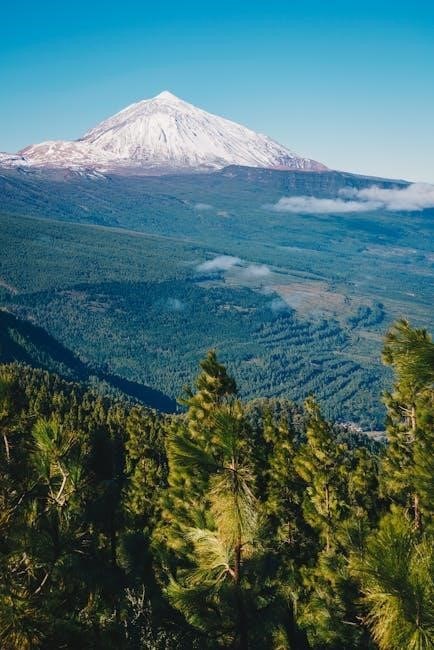
Troubleshooting Common Issues
What to Do If the Volcano Doesn’t Erupt
If the volcano fails to erupt, check the chemical mixture ratio and ensure sufficient eruption powder was added. Follow instructions carefully to avoid such issues.
If your volcano doesn’t erupt, first verify the chemical mixture ratio. Ensure the eruption powder is measured accurately and added correctly. Check if the baking soda and vinegar mixture is fresh. Avoid using stale ingredients, as they may reduce reactivity. Also, confirm the mold is sealed properly to build pressure. If issues persist, refer to the instruction manual for troubleshooting tips or adjust the mixture proportions as needed to achieve a successful eruption.
Fixing Cracks or Damage to the Structure
If cracks or damage occur, apply a small amount of plaster or modeling compound to the affected area. Let it dry completely before proceeding. Gently sand the repaired area for a smooth finish. Ensure the structure is stable and dry before painting or triggering an eruption. For severe damage, rebuild the section using the provided materials. Always handle the volcano with care to prevent further damage and follow safety guidelines for a successful experience.
Adjusting the Chemical Mixture
If the eruption is too weak or strong, adjust the chemical mixture. Add a small amount of eruption powder for a more vigorous reaction, but avoid exceeding the recommended quantity to prevent waste. If the mixture is too dry, add a few drops of water to achieve the right consistency. Always follow the instructions and safety guidelines when modifying the mixture. Small adjustments can significantly impact the eruption’s effectiveness. Test changes incrementally to achieve the desired result while ensuring a safe and fun experience.
Educational Value of the Kit
The National Geographic Volcano Kit fosters STEM skills, teaching kids about geological processes, volcanic eruptions, and Earth’s structure through hands-on, interactive learning, making science engaging and educational.
Learning About Volcanic Eruptions
The National Geographic Volcano Kit provides a hands-on approach to understanding volcanic eruptions. By simulating real geological processes, it helps users grasp the science behind eruptions, including magma movement and chemical reactions. The kit’s eruption process demonstrates how pressure builds and releases, mirroring natural volcanic activity. This interactive learning tool makes complex geological concepts accessible, fostering curiosity and a deeper understanding of Earth’s dynamic processes. It’s an ideal educational resource for students and science enthusiasts alike, encouraging exploration and critical thinking.
Understanding Geothermal Processes
The National Geographic Volcano Kit helps users explore geothermal processes by simulating the Earth’s internal heat and energy. The eruption process demonstrates how geothermal activity drives volcanic action, with chemical reactions mimicking magma movement. This hands-on experience simplifies complex geological concepts, making them accessible for learners of all ages. By observing the eruption, users gain insights into how heat and pressure interact within the Earth’s crust, fostering a deeper appreciation for geothermal dynamics and their role in shaping our planet’s surface.
Developing STEM Skills Through Hands-On Learning
The National Geographic Volcano Kit fosters STEM skills by engaging users in hands-on scientific exploration. Through assembly, eruption, and customization, kids develop critical thinking and problem-solving abilities. The kit encourages curiosity and creativity, teaching fundamental concepts of geology and chemistry. By following structured instructions and observing chemical reactions, learners enhance their analytical and scientific inquiry skills. This interactive approach makes complex STEM ideas accessible, promoting a deeper understanding of natural phenomena and inspiring a love for science and experimentation.
Additional Experiments and Creative Ideas
Explore multiple eruptions, add natural specimens, and customize your volcano further. Experiment with different chemical mixtures and volcano types to enhance learning and creativity, making science fun and engaging.
Creating Multiple Eruptions
To achieve multiple eruptions, adjust the chemical mixture ratio or use additional eruption powder. Start with a small amount of vinegar and baking soda, then gradually increase for stronger eruptions. For added realism, simulate lava flows by mixing food coloring with the eruption solution. Experiment with different intervals between eruptions to observe varying intensities. This feature makes the kit ideal for repeated use, allowing kids to explore geological processes creatively while enhancing their STEM skills through hands-on experimentation.
Adding Natural Specimens for Realism
Enhance your volcano’s authenticity by incorporating natural specimens like rocks, minerals, or sand. The kit often includes genuine volcanic samples for added realism. You can also collect safe, natural materials from your environment, such as small stones or soil, to create a more lifelike landscape. This step not only boosts the visual appeal but also helps kids learn about geological textures and formations. Encourage creativity by allowing them to personalize their volcano with these elements, making the project more engaging and educational.
Exploring Different Volcano Types
The National Geographic Volcano Kit encourages kids to explore various volcano types, such as shield, composite, and cinder cone volcanoes. By modifying the structure and eruption process, young scientists can replicate different geological formations. The kit’s eruption powder allows for multiple eruptions, enabling experimentation with varying intensities and styles. This hands-on approach helps kids understand the unique characteristics of each volcano type and their real-world counterparts, fostering a deeper appreciation for geological diversity and the dynamic processes of Earth’s surface.
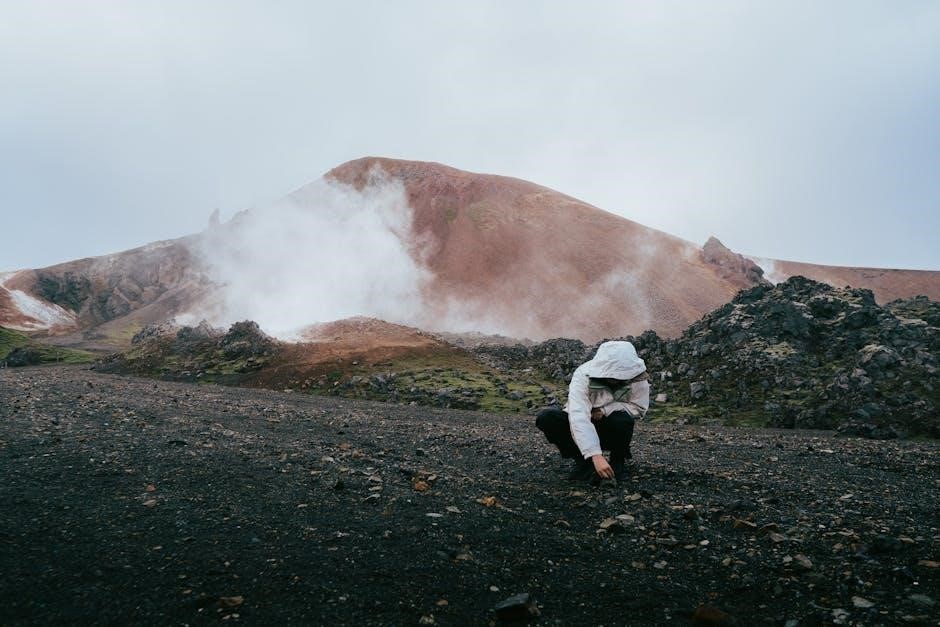
Customer Reviews and Feedback
Customers praise the National Geographic Volcano Kit for its educational value and engaging hands-on experience. Many highlight its ease of use and ability to spark curiosity in kids about geology and STEM concepts. While some note minor assembly challenges, overall feedback remains overwhelmingly positive, with parents and educators recommending it as a fun and informative science kit.
Positive Aspects of the Kit
The National Geographic Volcano Kit is highly praised for its engaging and educational design, making complex geological concepts accessible to children. Many users appreciate its ease of assembly and the detailed instructions provided, which ensure a smooth and enjoyable experience. The kit’s ability to create multiple eruptions adds excitement, while its focus on STEM learning fosters curiosity and creativity. Parents and educators often highlight its effectiveness in teaching Earth sciences in a hands-on manner, making it a standout choice for both fun and learning.
Common Complaints or Suggestions
Some users have noted that the chemical handling can be challenging for younger children, requiring closer adult supervision. The plaster drying time is lengthy, potentially frustrating for impatient kids. While the mold design is commended, a few users find it somewhat basic. There are suggestions for higher-quality paints and brushes to enhance customization. The instruction manual, though detailed, may be overwhelming for younger audiences. Some find the kit pricey compared to alternatives, and availability issues in certain regions are noted. Additionally, the eruption process can be messy, prompting calls for better cleanup guidance. Users also suggest including more educational content for a richer learning experience.
Comparisons with Similar Science Kits
The National Geographic Volcano Kit stands out among other science kits for its educational depth and hands-on learning experience. While other kits may offer similar eruption mechanisms, this one excels with its detailed instructions and inclusion of realistic geological specimens. Some users compare it favorably to competing brands, praising its durability and ease of assembly. However, a few note that the price is slightly higher than alternatives. Despite this, the kit’s comprehensive approach to teaching volcanic processes makes it a top choice for STEM enthusiasts, even if assembly times and drying phases can be lengthy for impatient users.
The National Geographic Volcano Kit is an excellent STEM tool, offering a fun, interactive way to learn about geology. Its detailed instructions ensure safety and success, making it a great educational experience for kids and families. With positive reviews and a focus on hands-on learning, this kit is a standout choice for science enthusiasts.
The National Geographic Volcano Kit is a STEM-focused educational tool designed for kids aged 8 and above. It provides a hands-on experience, teaching geological concepts through assembly and eruption simulations. The kit includes eruption powder, plaster, and painting supplies, with detailed instructions for safe and successful use. Users praise its educational value and ease of assembly, though some suggest clearer instructions for complex steps. Overall, it’s a engaging way to explore science and geology, fostering curiosity and learning through interactive experiments.
Encouragement to Try the Kit
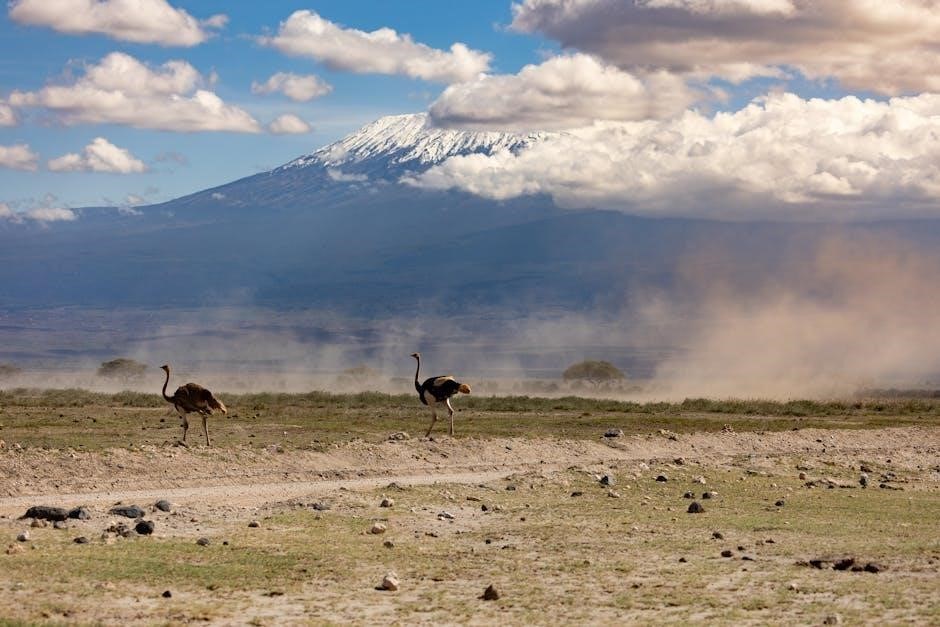
With its comprehensive instructions and engaging design, the National Geographic Volcano Kit is perfect for curious learners of all ages. It offers a unique opportunity to explore geological processes while enjoying a fun, hands-on experience. The kit’s STEM-focused approach makes it ideal for science enthusiasts and educators alike. By following the detailed guide, users can create an erupting volcano, fostering creativity and a deeper understanding of natural phenomena. Don’t miss this chance to make learning exciting and interactive!
Final Safety Reminders
Always handle chemicals with care and wear protective gloves. Ensure adult supervision for children under 12. Follow instructions precisely to avoid accidents. Keep the kit away from flammable materials and heat sources. Clean up spills immediately and wash hands thoroughly. Store components safely after use. By adhering to these guidelines, you can enjoy a safe and educational experience with the National Geographic Volcano Kit. Remember, safety is key to a fun and successful eruption!
